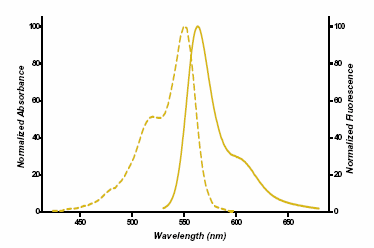Cyanine 3-dUTP can replace TTP in reactions in which it serves as a substrate for E. coli DNA polymerase (holoenzyme and Klenow fragment), T4 and Taq DNA polymerases, reverse transcriptase (from AMV and M-MuLV) and terminal transferase. Fluorescently labeled probes can be prepared with this fluorescent nucleotide by a variety of methods including nick translation, cDNA labeling and 3’-end labeling. Probes generated by these methods are suitable for use for the identification of specific sequences by in situ hybridization procedures on fixed cells and tissues by direct fluorescence detection. Cyanine 3-dUTP can also be used for multicolor fluorescence labeling.
Product Details
| Alternative Name: | Cyanine 3-deoxyuridine-5’-triphosphate |
| |
| Concentration: | 1mM |
| |
| Formulation: | Liquid. Solution in water. |
| |
| Excitation maximum: | 550 nm |
| |
| Emission maximum: | 564 nm |
| |
| Extinction Coefficient: | 150,000 M-1 cm-1 (550 nm in TE [10 mM TRIS, pH 8.0, 1 mM EDTA]) |
| |
| Purity: | ≥93% (HPLC) |
| |
| Purity Detail: | Purified by ion-exchange chromatography. |
| |
| Appearance: | Dark pink liquid. |
| |
| Shipping: | Dry Ice |
| |
| Long Term Storage: | -20°C |
| |
| Use/Stability: | Stable for at least one year after receipt when stored as recommended. |
| |
| Handling: | Protect from light. Avoid freeze/thaw cycles. |
| |
| Technical Info/Product Notes: | Several of Enzo’s products and product applications are covered by US and foreign patents and patents pending. |
| |
| Regulatory Status: | RUO - Research Use Only |
| |
Please mouse over
Product Literature References
A Satellite-Free Centromere in Equus przewalskii Chromosome 10: F.M. Piras, et al.; Int. J. Mol. Sci.
24, 4134 (2023),
Abstract;
Feasibility and Toxicity of Interval-Compressed Chemotherapy in Asian Children and Young Adults with Sarcoma: J.H. Huang, et al.; J. Pers. Med.
13, 668 (2023),
Abstract;
Identification of COL1A1/2 Mutations and Fusions With Noncoding RNA Genes in Bizarre Parosteal Osteochondromatous Proliferation (Nora Lesion): Y.C. Kao, et al.; Mod. Pathol.
36, 100011 (2023),
Abstract;
Development of anti-somatostatin receptors CAR T cells for treatment of neuroendocrine tumors: B. Mandriani, et al.; J. Immunother. Cancer
10, e004854 (2022),
Abstract;
Large-scale genome editing based on high-capacity adenovectors and CRISPR-Cas9 nucleases rescues full-length dystrophin synthesis in DMD muscle cells: F. Tasca, et al.; Nucleic Acids Res.
50, 7761 (2022),
Abstract;
Characterization of axolotl lampbrush chromosomes by fluorescence in situ hybridization and immunostaining: M.C. Keinath, et al.; Exp. Cell Res.
401, 112523 (2021),
Abstract;
Gene-Based Method for Cytogenetic Mapping of Repeat-Rich Mosquito Genomes: R. Masri, et al.; Insects
12, 138 (2021),
Abstract;
Full Text
Identification of Mutant Genes and Introgressed Tiger Salamander DNA in the Laboratory Axolotl, Ambystoma mexicanum: M.R. Woodcock, et al.; Sci. Rep.
7, 6 (2017),
Abstract;
Full Text
Cellular and Molecular Features of Developmentally Programmed Genome Rearrangement in a Vertebrate (Sea Lamprey: Petromyzon marinus): V. Timoshevskiy, et al.; PLoS Genet.
6, e1006103 (2016),
Application(s):DNA probe preparation and fluorescence in situ hybridization (FISH),
Abstract;
Full Text
Amplification-free sequencing of cell-free DNA for prenatal non-invasive diagnosis of chromosomal aberrations: K. Karlsson, et al.; Genomics
105, 150 (2015),
Application(s): Oligonucleotide Array,
Abstract;
Full Text
Preparation and biomedical applications of programmable and multifunctional DNA nanoflowers: Y. Lv, et al.; Nat. Protoc.
10, 1508 (2015),
Application(s): Labeling of cDNA,
Abstract;
The significance of MUM1/IRF4 protein expression and IRF4 translocation of CD30 (+) cutaneous T-cell lymphoproliferative disorders: a study of 53 cases: T. Kiran, et al.; Leuk. Res.
37, 396 (2013),
Abstract;
Frequency of aneuploidy related to age in porcine oocytes: M. Hornak, et al.; PLoS One
6, e18892 (2011),
Abstract;
Full Text
Gestational nicotine treatment modulates cell death/survival-related pathways in the brains of adolescent female rats: J. Wie, et al.; Int. J. Neuropsychopharmacol.
14, 91 (2011),
Abstract;
Modulation of cell adhesion systems by prenatal nicotine exposure in limbic brain regions of adolescent female rats: J. Cao, et al.; Int. J. Neuropsychopharmacol.
14, 157 (2011),
Abstract;
General Literature References
DNA MIcroarrays: A Molecular Cloning Manual: D. Bowtell & J. Sambrook (eds.); Cold Spring Harbor Laboratory Press (2003),
Abstract;
DNA arrays for analysis of gene expression: M.B. Eisen & P.O. Brown; Methods Enzymol.
303, 179 (1999),
Abstract;
A DNA microarray system for analyzing complex DNA samples using two-color fluorescent probe hybridization: D. Shalon, et al.; Genome Res.
6, 639 (1996),
Abstract;














